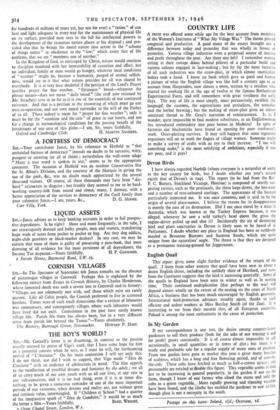COUNTRY LIFE
A PRIZE was offered some while ago for the best account from members of the Women's Institutes of " What My Village Was." The theme proved congenial and productive. A good many of the essays brought out a difference between today and yesterday that was wholly in favour of yesterday. Various village industries were a perpetual source of interest and profit throughout the year. Are there any left? I remember women sitting at their cottage doors behind pillows of a particular build and various colours engaged in lace-making ; but by far the most lucrative of all such industries was the straw-plait, 'in which almost inarticulate babies took a hand. I know no book which gave so good and human a picture of what the English village was like half a century ago as an account from Harpenden, now almost a town, written by a resident who started his working life at the age of twelve at the famous Rothamsted Experimental Farm, and still remembers with great vividness the early
days. The way of life is most simply, most persuasively, recalled, the language, the customs, the superstitions and prejudices, the remedies
and the herbal brewing ; but the making of straw-plait gives an almost continual thread to Mr. Gray's narration of reminiscences. Is it, I wonder, quite impossible to find modern substitutes, as an Englishwoman has introduced embroidery into poor homes in Madeira? In spite of
factories our blacksmiths have found an opening for pure cratfsman's work. Osier-plaiting survives. It may still happen that some ingenious organisers will set to work the fingers of village women. Someone ought to make `a survey of crafts with an eye to their increase. " I too will something make," is the most satisfying of ambitions, especially if you are poor, and it pays!


























 Previous page
Previous page